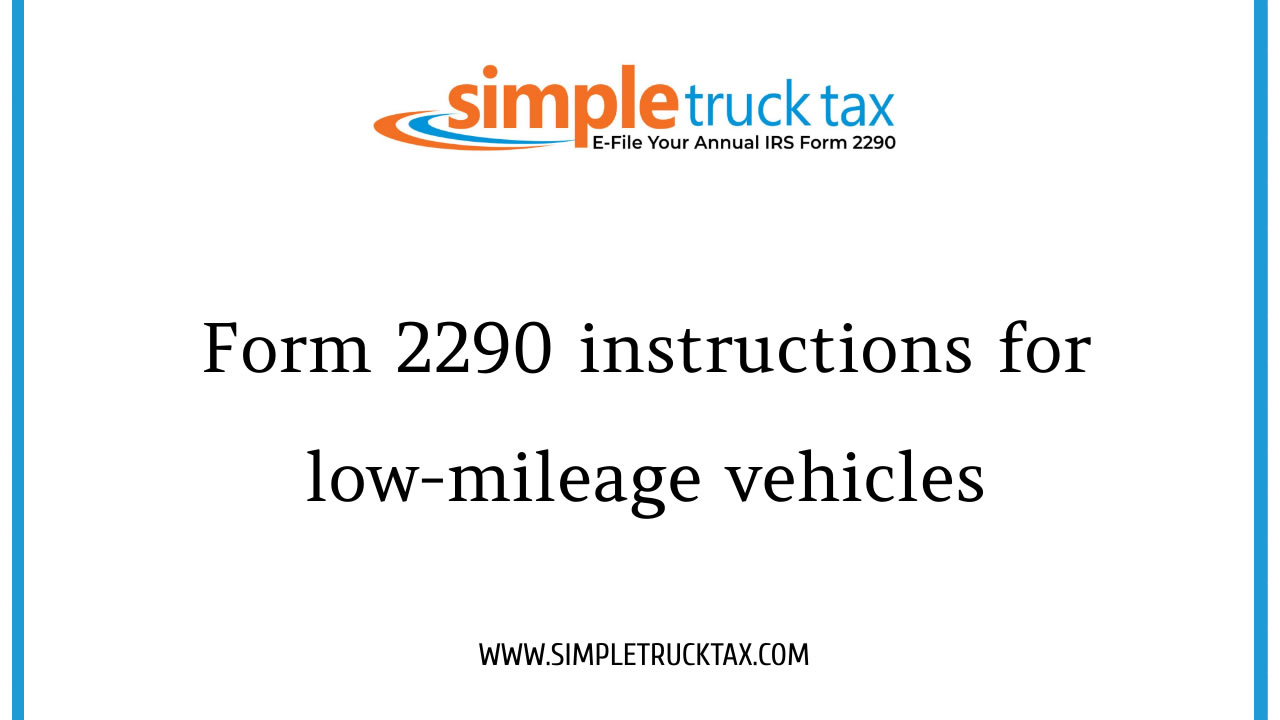10-23-2024
Form 2290 instructions for low-mileage vehicles
If you are driving heavy highway vehicles, you are bound to know Form 2290 wherein one has to report and pay Heavy Vehicle Use Tax (HVUT) to the IRS. However, in case the selected vehicle is identified as low-mileage or suspended, the filing process and tax liability changes. So, you need to know how to fill Form 2290 correctly for low-mileage vehicles so that you need not pay some amount of tax unnecessarily.
In this article, we are going to outline everything you need to know about filing Form 2290 for the suspended vehicles, or low-mileage vehicles, so you do not make a mistake at the time of filing it.
What is a Low-Mileage Vehicle?
A heavy vehicle as defined by the IRS guidelines is a heavy vehicle with public highways travelled below 5000 miles in the tax period (7,500 miles for agricultural vehicles). Suspending the HVUT if it falls under the mileage limits but incurring no tax, the owner must file Form 2290 to enjoy the status of the vehicle.
Why should I report if there's no tax due?
You're required by the IRS to file a report for all heavy highway vehicles subject to HVUT, even in a year that qualifies it for a tax suspension due to minimal mileage. This will keep your vehicle in good standing and your truck will also get a Schedule 1 proof of filing needed for continuing the renewal of your registration.
Instructions for Form 2290: Low-Mileage Vehicles
Here are the instructions for completing and submitting Form 2290 properly for low-mileage vehicles.
Step 1: Identify Your Low-Mileage Vehicles
Before you start: Determine which vehicles are less than 5,000 miles for your reporting period. Make sure you keep a ledger indicating the mileage of each vehicle. Vehicles with more than 5,000 miles (more than 7,500 miles for agricultural vehicles) cannot be suspended and have to be paid in full HVUT.
Step 2: Gather All Required Data to Be Vouched Upon
To file Form 2290, you will need to collect the following data:
- EIN: The Form 2290 is to be filled with the help of an EIN. A Social Security Number (SSN) will not be accepted.
- VINs: Each low mileage vehicle needs a proper VIN.
- Taxable Gross Weight: Taxable gross weight is the weight category of the vehicle. This consists of the unloaded weight of the vehicle and trailers along with the maximum load that the vehicle can carry.
Step 3: Fill Part I of Form 2290
- In Part I of the form, mark check box line , marking off the fact that the vehicle qualifies for suspension as there is an expectation that it has fewer than the mileage limit.
- Mark first month of use in the appropriate space. In the case of low mileage vehicles it will be when you first used the vehicle on public highways during the current tax period. Form 2290 tax period starts on July 1 and ends on June 30 of the next year .
Step 4: Complete Part II and List the Suspended Vehicles
- On line 9 of Part II you will list all your low-mileage vehicles being suspended. Provided information includes VIN for each vehicle and your gross taxable weight class. Understand that the entries for VIN can easily result in errors or rejections of the filing.
- If Paper Filing Attach Schedule 1 to Form 2290. If you are e-filing, Schedule 1 will automatically be generated. If you are paper filing, complete Schedule 1 listing all of your low mileage vehicles reported in Part II and attach it to Form 2290.
Step 5: Sign and Submit the Form
Now, sign the form with an electronic signature if you're filing electronically, or a wet signature if you are mailing it. It's especially appreciated by fleet owners and operators who like to file electronically because it is quicker to do so than if it were mailed. Generally, it takes a mere minute for an approval of Schedule 1 via an electronic filing and weeks if it is mailed.
Step 6: Track Your Mileage Accurately
You claim low-mileage vehicles, yet you also must maintain records that reflect each reported vehicle stayed under the 5,000 mile limit (or 7,500 miles for agriculture) for the entire tax period. The IRS can request such records during an audit.
How Do You File Form 2290 for Low-Mileage Vehicles?
Form 2290 is filed by August 31st every year for vehicles put into use in July. In case you put your vehicle into service later in the calendar year, you are supposed to file by the last day of the month following the first month of use. Thus, if you put your vehicle into service during November, then your Form 2290 is due by December 31st.
What If My Vehicle Is Used Over 5,000 Miles?
If a vehicle which you had claimed as low mileage crosses the 5,000-mile limit during the tax period, then you are liable to file an amended Form 2290 and pay the HVUT applicable for that vehicle. The amended return is to be filed by the last day of the month succeeding the month when the mileage limit has been crossed. For example, if a vehicle crosses the limit in April then the amended return must be filed by 31 May.
Advantages to E-Filing for Low-Mileage Vehicles
Low-mileage fleet managers and private truck owners will have many more advantages in e-filing:
- VINs and Tax Period Verification E-filing ensures that VINs, plus tax periods, are automatically checked against possible disqualifications.
- Faster Receipt of Validated Schedule 1 E-filing will get them their validated Schedule 1 in only minutes or hours, renewing their registrations without waiting.
- Automated Record Keeping All filing history made to the E-filing service can be accessed from one location, such as your account on the e-file website.
Filing Form 2290 on Low Mileage Vehicles- Important Points.
- File on time: Don't become a victim of the August 31st deadline, or last day of the following month beyond the first use of any vehicle.
- Keep track of your mileage: You'll have precise records to defend your lower mileage claims in case the IRS decides to audit you.
While Form 2290 for low mileage vehicles might be a relatively painless form, mistakes or failure to pay attention to the details can quickly create more bother. All these requirements and steps can help guide you through the process of filing without even having to step into an account. E-filing is a more convenient and secure method of fulfilling your obligations, and thus it would allow you to get that much-needed Schedule 1 sooner. Whether you are a fleet manager or an independent trucker, learning the process of how to file for a Form 2290 on low mileage vehicles could be the best approach to always keeping things rolling and stress-free.
Note: For more information, visit IRS website


